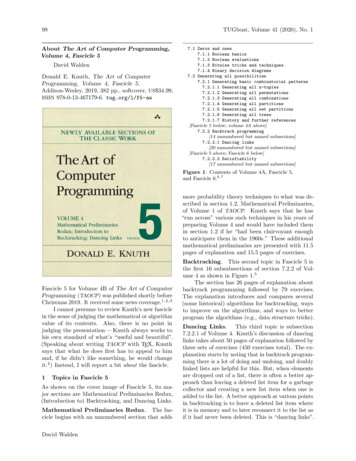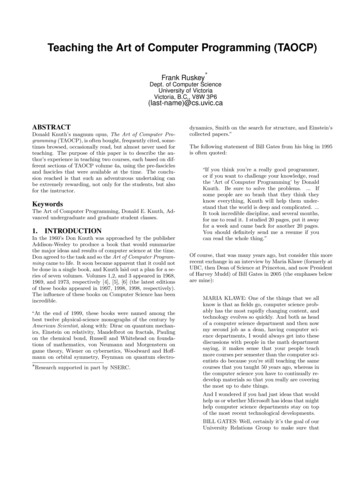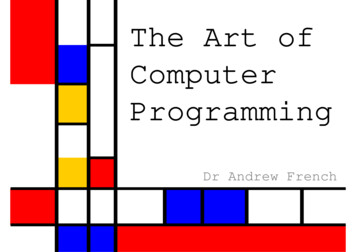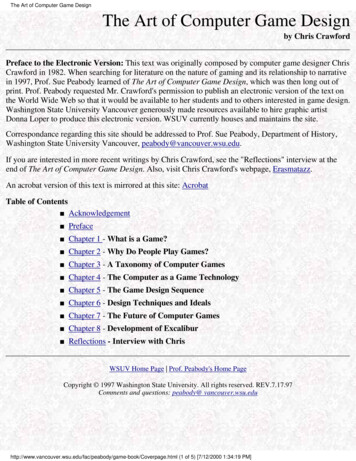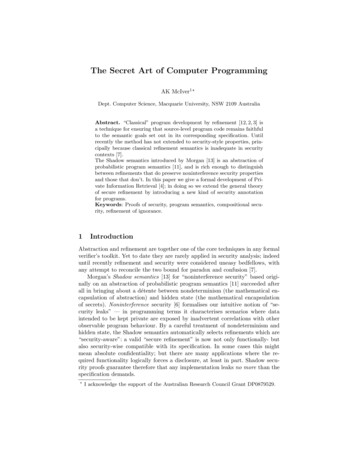
Transcription
The Secret Art of Computer ProgrammingAK McIver1?Dept. Computer Science, Macquarie University, NSW 2109 AustraliaAbstract. “Classical” program development by refinement [12, 2, 3] isa technique for ensuring that source-level program code remains faithfulto the semantic goals set out in its corresponding specification. Untilrecently the method has not extended to security-style properties, principally because classical refinement semantics is inadequate in securitycontexts [7].The Shadow semantics introduced by Morgan [13] is an abstraction ofprobabilistic program semantics [11], and is rich enough to distinguishbetween refinements that do preserve noninterference security propertiesand those that don’t. In this paper we give a formal development of Private Information Retrieval [4]; in doing so we extend the general theoryof secure refinement by introducing a new kind of security annotationfor programs.Keywords: Proofs of security, program semantics, compositional security, refinement of ignorance.1IntroductionAbstraction and refinement are together one of the core techniques in any formalverifier’s toolkit. Yet to date they are rarely applied in security analysis; indeeduntil recently refinement and security were considered uneasy bedfellows, withany attempt to reconcile the two bound for paradox and confusion [7].Morgan’s Shadow semantics [13] for “noninterference security” based originally on an abstraction of probabilistic program semantics [11] succeeded afterall in bringing about a détente between nondeterminism (the mathematical encapsulation of abstraction) and hidden state (the mathematical encapsulationof secrets). Noninterference security [6] formalises our intuitive notion of “security leaks” — in programming terms it characterises scenarios where dataintended to be kept private are exposed by inadvertent correlations with otherobservable program behaviour. By a careful treatment of nondeterminism andhidden state, the Shadow semantics automatically selects refinements which are“security-aware”: a valid “secure refinement” is now not only functionally- butalso security-wise compatible with its specification. In some cases this mightmean absolute confidentiality; but there are many applications where the required functionality logically forces a disclosure, at least in part. Shadow security proofs guarantee therefore that any implementation leaks no more than thespecification demands.?I acknowledge the support of the Australian Research Council Grant DP0879529.
The Shadow approach is distinguished from other methods for security analysis in its emphasis on compositionality and the development-by-hierarchy thatcompositionality supports. Specifications are now programs too –though mostlikely inefficient and tacit as to algorithmic detail– yet as we have learned frommany years’ experience with the refinement calculus, a focus on what we wantpays off “in spades” for understanding systems. Adding detail devolves to thevalidation of refinement steps, each one small enough for the proofs to be –almost– automatic, and furthermore achieved at the source level. And, as forclassical refinement, we often call on specifications of sub-protocols whereverthis simplifies the reasoning, leading to the method’s ability to accommodateprotocols of unbounded state [10].Our contribution in this paper is a formal development of a scheme forPrivate Information Retrieval in public databases [4]. In doing so we extend thetheory by the introduction of “visibility annotations” for reasoning about theextent to which a secret is revealed during program execution.We begin with a summary and commentary on the basics for non-interferencesecurity using the Shadow semantics. Throughout we use left-associating dotfor function application, so that f.x.y means (f (x))(y) or f (x, y), and we take(un-)Currying for granted where necessary. Comprehensions/quantifications arewritten uniformly, as (Qx: T R·E) for quantifier Q, bound variable(s) x of type(s)T , range-predicate R (probably) constraining x and element-constructor E inwhich x (probably) appears free: for sets the opening “(Q” is “{” and the closing“)” is “}” so that e.g. the comprehension {x, y: N y 2x · yz} is the set ofnumbers z, 2z, 4z, · · · .2Semantics for programming with secretsA non-interference -secure program is one where an attacker (discussed below)cannot infer “hidden” variables’ initial values from “visible” variables’ values(initial or final). With just two variables v, h of class visible, hidden resp. suppose a possibly nondeterministic program r takes initial states (v, h) to setsof final visible states v 0 and so is of type V H PV, where V, H are thevalue sets corresponding to the types of v, h. Such a program r is then noninterference -secure just when for any initial visible the set of possible finalvisibles is independent of the initial hidden [8, 15], that is for any v: V we have h0 , h1 : H · r.v.h0 r.v.h1 .In our approach [13] we extend this view, in several stages. The first is toconcentrate on final- (rather than initial) hidden values and therefore to modelprograms as V H P(V H). For two such programs r{1,2} we say that r1 v r2 ,that r1 “is securely refined by” r2 , whenever both the following hold:(i) For any initial state v, h each possible r2 outcome v 0 , h0 is also a possibler1 outcome, that is for all v: V and h: H we have r1 .v.h r2 .v.h .This is the classical “can reduce nondeterminism” form of refinement.
(ii) For all v: V, h: H and v 0 : V satisfying h02 : H · (v 0 , h02 ) r2 .v.h , we havethat (v 0 , h0 ) r1 .v.h implies (v 0 , h0 ) r2 .v.h for all h0 : H.This second condition says that for any observed visibles v, v 0 and any initial h the attacker’s “deductive powers” w.r.t. final h0 ’s cannot be improvedby refinement: there can only be more possibilities, never fewer.In this simple setting, as an example restrict all our variables’ types so thatV H {0, 1}, and let r1 be the program that can produce from any initial values(v, h) any one of the four possible (v 0 , h0 ) final values in V H (so that the finalvalues of v and h are uncorrelated). Then the program r2 that can produce onlythe two final values {(0, 0), (0, 1)} is a secure refinement of r1 ; but the program r3that produces only the two final values {(0, 0), (1, 1)} is not a secure refinement(although it is a classical one).The difference between r2 and r3 is that although r2 reduces r1 ’s visible nondeterminism, it does not affect the hidden nondeterminism in h0 . In r3 , however,variables v 0 and h0 have become correlated.2.1The Shadow H of h records h’s inferred valuesIn r1 above the set of possible final values of h0 was {0, 1} for each v 0 separately.This set is called “The Shadow,” and represents explicitly an attacker’s ignoranceof h0 : it is the smallest set of possibilities he can infer. In r2 that shadow was thesame; but in r3 the shadow was smaller, just {v 0 } for each v 0 , and that is whyr3 was not a secure refinement of r1 .In the shadow semantics we track this inference, so that our program statebecomes a triple (v, h, H) with H a subset of H — and in each triple the Hcontains exactly those (other) values that h might have had, including the one itactually does have. The (extended) output triples of the three example programsare then respectivelyr1 — {(0, 0, {0, 1}), (0, 1, {0, 1}), (1, 0, {0, 1}), (1, 1, {0, 1})}r2 — {(0, 0, {0, 1}), (0, 1, {0, 1})}r3 — {(0, 0, {0}), (1, 1, {1})} ,and we have r1 v r2 because r1 ’s set of outcomes includes all of r2 ’s. But for r3we find that its outcome (0, 0, {0}) does not occur among r1 ’s outcomes, nor isthere even an r1 -outcome (0, 0, H 0 ) with H 0 {0} that would satisfy (ii). That,again, is why r1 6v r3 .For sequential composition of shadow-enhanced programs, not only final- butalso initial triples (v, h, H) must be dealt with: the final triples of a first component become initial triples for a second. We now define the shadow semanticsexactly, in stages, by showing how those triples are generated for straight-lineprograms.2.2The Shadow Semantics of atomic programs
Publish a valueAssign to visibleAssign to hiddenChoose visibleChoose hiddenExecute atomicallySequential compositionDemonic choiceConditionalProgram PSemantics [[P ]].v.h.Hreveal E.v.h{ (v, h, {h0 : H E.v.h0 E.v.h}) }v: E.v.hh: E.v.hv: S.v.hh: S.v.h{ (E.v.h, h, {h0 : H E.v.h0 E.v.h}) }{ (v, E.v.h, {h0 : H · E.v.h0 }) }{v 0 : S.v.h · (v 0 , h, {h0 : H v 0 S.v.h0 }) }{h0 : S.v.h · (v, h0 , {h0 : H; h00 : S.v.h0 · h00 }) }hhP iiP1 ; P2P1 u P2addShadow.(“classical semantics of P ”)lift.[[P2 ]].([[P1 ]].v.h.H)[[P1 ]].v.h.H [[P2 ]].v.h.Hif E.v.h then Pt else Pf fi?[[Pt ]].v.h.{h0 : H E.v.h0 true}C E.v.h B[[Pf ]].v.h.{h0 : H E.v.h0 false}The syntactically atomic commands A marked ? have the property that A hhAii.This is deliberate: syntactic atoms execute atomically. The function lift.[[P2 ]] applies[[P2 ]] to all triples in its set-valued argument, un-Currying each time, and then takesthe union of all results.The extension to many variables v1 , v2 , · · · and h1 , h2 , · · · , including local declarations,is straightforward [13, 14].Fig. 1. Semantics of non-looping commandsA classical program r is an input-output relation between V H -pairs. Considered as a single, atomic action its shadow-enhanced semantics addShadow.r is arelation between V H PH -triples and is defined as follows:Definition 1. Atomic shadow semantics Given a classical program r: V H P(V H) we define its shadow enhancement addShadow.r of type V H PH P(V H PH) so that addShadow.r.v.h.H 3 (v 0 , h0 , H 0 ) just when(i) we have both r.v.h 3 (v 0 , h0 ) (ii) and H 0 {h0 : H h00 : H · r.v.h00 3 (v 0 , h0 ) } .— classical— shadow Clause (i) says that the classical projection of addShadow.r’s behaviour is thesame as the classical behaviour of just r itself. Clause (ii) says that the finalshadow H 0 contains all those values h0 compatible with allowing the originalhidden value to range as h00 over the initial shadow H.2.3Security-aware program refinementEquality of programs is a special case of refinement, whence compositionality isa special case of monotonicity: two programs with equal semantics in isolationmust remain equal in all contexts. With those ideas in place, we define refinementas follows:
Definition 2. Refinement For programs P{1,2} we say that P1 is securelyrefined by P2 and write P1 v P2 just when for all v, h, H we have( (v 0 , h0 , H20 ): [[P2 ]].v.h.H · H10 : PH H10 H20 ·(v 0 , h0 , H10 ) [[P1 ]].v.h.H ) ,with [[·]] as defined in Fig. 1.This means that for each initial triple (v, h, H) every final triple (v 0 , h0 , H20 )produced by P2 must be “justified” by the existence of a triple (v 0 , h0 , H10 ), withequal or smaller shadow, produced by P1 under the same circumstances. 3Programming with hidden stateWhat makes security analysis difficult is the seeming incompatibility of bothkeeping a secret and using it in “public computations.” In this section we summarise the characteristics of the Shadow semantics that allow us to analyse theextent to which information is revealed at runtime.Runtime visibility and in-visibility. A visible variable is one whose runtimevalue can be “observed” after each (atomic) execution. For example, the resolution of the nondeterministic choice in the program v: {0, 1} can be determinedsimply by reading the final value of the visible variable v. Assignments to hiddenvariables, in contrast, cannot be observed directly. Thus the program h: {0, 1}reveals nothing about h at runtime beyond what can be gleaned statically byexamining the source code: we deduce that it is either 0 or 1; but we don’t knowwhich.Interaction and information flow. More interesting is when visible and invisible variables interact, for that is where correlations are formed. Direct publication of the hidden state results in a direct correlation, for example v: heffectively announces h’s value. Moreover once the information is in the public domain, no amount of track-covering can erase the knowledge. The programv: h; v: 0 also leaks h, even though v is overwritten immediately afterwards —that is because our attack model [10] assumes that an observer can see the the results of visible computations after each “atomic step,” which is normally definedby sequential composition (but see atomicity below). In addition an observermay make deductions based on his run-time observations and the structure ofthe program code. Thus in principle attackers have perfect recall [13, 14].This curious interaction of hidden and visible assignments means sequentialcomposition becomes a somewhat strange operator — for instance it no longersatisfies the rule (v: h; v: 0) v: 0. Luckily these idiosyncracies are limitedto visible/hidden interactions, with the classical rules continuing to apply asnormal in the cases where the reasoning is entirely between visible variables.Compositionality and refinement. Two programs are judged to be the sameif and only if they are both functionally equivalent and have identical “security
defences.” The latter is crucial to our hierarchical development method, for itimplies that one program may be replaced by its equivalent in any context,without fear of unanticipated security flaws. In our examples below we will usenot-necessarily-executable programs as specifications to articulate our overallsecurity goals.When reasoning about programs we are able to assume the normal structural rules, so for example P uQ v P , and (if E.v.h then Pt else Pf fi); Q if E.v.h then Pt ; Q else Pf ; Q fi. We also use the fact that decreasing visibilityis always a secure refinement, i.e. [vis x · · · ] v [hid x · · · ] , where we have used“visibility declarations” (discussed below) to assign the visibility attribute to thevariable x.Atomicity: controlling granularity. Explicit atomicity is necessary for hiding
The Secret Art of Computer Programming AK McIver1? Dept. Computer Science, Macquarie University, NSW 2109 Australia Abstract. \Classical" program development by re nement [12,2,3] is a technique for ensuring that source-level program code remains faithful to the semantic goals set out in its corresponding speci cation. Until recently the method has not extended to security-style properties .




